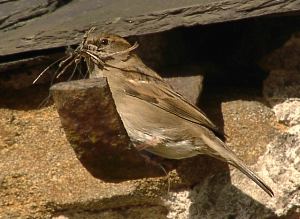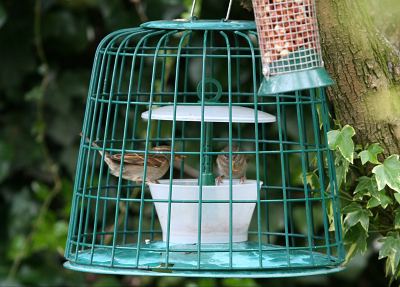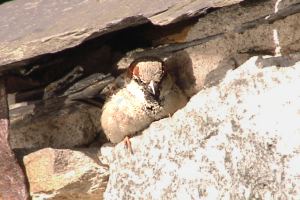
Many people recall the cheeky sparrows of the 20th century with fondness, and don't want to see them go. Why there has been a general decline of the sparrow in urban areas is the subject of ongoing study. No single cause has been fingered for the fall in numbers, and indeed it may be due to a combination of factors.
One of the observations that is coming out of the studies is that nestlings are starving in the nest, particularly the later broods. This is because the nestlings are fed on an insect diet, which is not typical of the adult sparrow diet, which is largely grain and seed. The adults are not able to find enough insects to keep the number of nestlings alive needed to replace the sparrows that have died over the year. The population therefore slowly falls over time until the sparrows lose heart and the colony fails.
You can help sparrows with this by providing foods (sunflower hearts are a favourite) and growing native plants and hedges to encourage insects. Sparrows spend many hours chirping together in hedges so preserve any you have. Nesting sites are important too (a 32mm nest box/boxes near the house eaves). They may not immediately use external boxes and often take at least a year before adopting them.

For the devoted you can provide live mealworms during the breeding season (May to September). This is exactly what one study is trying out in London to attempt to arrest the decline.
These are available from pet shops and the cheapest place I have found online is http://www.livefoodsdirect.co.uk If you have starlings visiting you may need to place these in a cage because mealworms do not last for long with starlings! Blackbirds, dunnocks, wrens and robins also love mealworms. Blackbirds and robins can become quite tame "asking" you for them, particularly if they have young mouths to feed.
The mealworm feeder is available from CJ Wildbird. The steel cage is the "Guardian pack".
Observation shows that areas which have a lot of sparrows in the town are different in character from those with few. Often it is what you don't do which matters as much as what you do. This is summarised in the DEFRA leaflet
Changes in gardens, however, are probably an important reason for their decline. There are fewer weedy corners for birds to feed in, and there seem to be fewer insects around to feed the chicks. House sparrows also like resting and hiding in old, dense, ivy and other bushes, many of which are disappearing as gardens are 'made-over'. Development of inner-city, 'brownfield', sites may also mean that there are fewer places for the house sparrow to find food.
Like any creature, the sparrow needs a place to be, food to eat and somewhere to breed. Sparrows are more numerous where there is plenty of vegetation and hedges. They aren't fans of decking, or front gardens converted to hard standing for cars, which reduces the availability of food. Cover is an issue for sparrows in the suburban environment, and it is a shame for them that hedges are falling out of favour. One of the things sparrows really like to do is gather in a hedge and get a really good chirp going amongst themselves like this lot in Rendlesham
and these in Ipswich.
Privet hedges used to be a widespread feature of the suburban landscape when councils planted them as boundaries for council houses. Hedges have often been removed to create parking spaces in front gardens. Privet was a particular favourite of sparrows, and provide all year cover as they are evergreen. A number of older gardens in Ipswich have holly hedges which similarly find favour with house sparrows, and I have found two winter roosts in holly trees.

The classic nesting site for sparrows is the eaves of a roof. Unlike squirrels or rats the sparrows don't seem to go into the roof cavity - their nest is usually just under the first tiles/slates or so within a couple of inches of the entrance. Modern building codes mean that the roof is usually inaccessible to sparrows, and it is notable that several respondents to the survey said that sparrows had been nesting in derelict buildings and old commercial buildings and the colony had been eliminated or moved on when the building was demolished or renovated. We're not suggesting you let your roof collapse, but if you do have your roof redone or uPVC soffits and guttering installed then you might want to put up a sparrow nestbox nearby to give your sparrows a place they can call home.
Thanks to Helen for this article from 2006